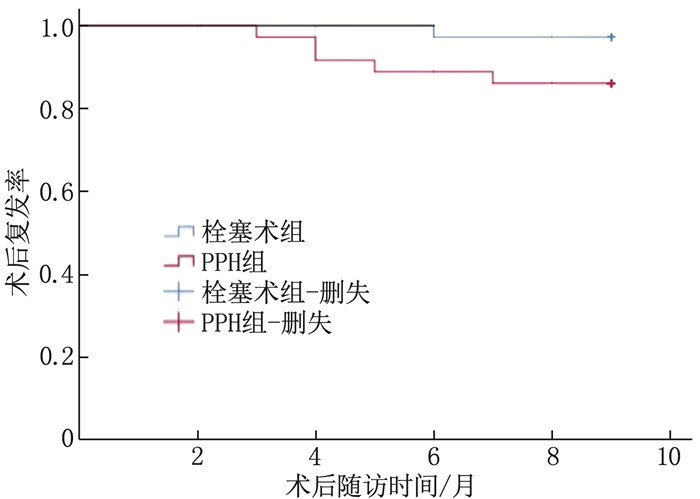Clinical safety and effectiveness of upper rectal artery embolization in patients with internal hemorrhoids
-
摘要:目的
探讨直肠上动脉介入栓塞术治疗Ⅱ~Ⅳ度内痔的临床安全性和有效性。
方法选取确诊为内痔Ⅱ~Ⅳ度的患者72例为研究对象,按照随机数字表法将其分为痔上黏膜环形切除钉合术(PPH)组及栓塞术组,每组36例。栓塞术组患者采用直肠上动脉介入栓塞术进行干预,PPH组患者采用PPH术式进行干预。比较2组患者围术期各项指标、术后并发症、临床疗效及术后肛门症状相关评分情况,观察患者内痔复发情况。
结果栓塞术组临床治疗总有效率高于PPH组,差异有统计学意义(P < 0.05); 栓塞术组手术时间、住院时间、术中出血量、创面愈合时间与PPH组比较,差异有统计学意义(P < 0.05); 栓塞术组术后症状评分及并发症总发生率均低于PPH组,差异有统计学意义(P < 0.05)。Kaplan-Meier曲线联合Log-rank检验显示, 2组术后9个月复发情况比较,差异无统计学意义(P=0.09)。
结论直肠上动脉栓塞术对以出血为主的Ⅱ~Ⅳ度内痔有良好的疗效,对提高临床治疗有效率、促进患者快速恢复及改善临床不良反应具有积极意义。
Abstract:ObjectiveTo investigate the clinical safety and effectiveness of upper rectal artery embolization in the treatment of grade Ⅱ to Ⅳ internal hemorrhoids.
MethodsA total of 72 patients diagnosed with grade Ⅱ to Ⅳ internal hemorrhoids were selected as study objects. A random number table method was used to divide these patients into postpartum hemorrhage (PPH) group and embolization group, with 36 cases in each group. Embolization group was treated with upper rectal artery embolization, and PPH group was treated with PPH operation. Perioperative indicators, postoperative complications, clinical efficacy and postoperative anal symptoms were compared between the two groups, and the recurrence of internal hemorrhoids was observed.
ResultsThe total effective rate of embolization group was higher than that of the PPH group (P < 0.05). The operative time, hospital stay, intraoperative blood loss and wound healing time of the embolization group showed statistically significant differences compared with those of the PPH group (P < 0.05). The score of postoperative symptoms and the total incidence of complications in the embolization group were lower than those in the PPH group, and the differences were statistically significant (P < 0.05). Kaplan-Meier curve combined with Log-rank test showed no statistical significance difference in recurrence 9 months after surgery was seen between the two groups (P=0.09).
ConclusionThe upper rectal artery embolization has a good effect in the treatment of Ⅱ to Ⅳ degree of hemorrhoids mainly manifesting as bleeding, and has positive significance in improving the clinical efficiency, promoting the rapid recovery and improving the clinical adverse symptoms.
-
-
表 1 2组患者临床治疗总有效率比较[n(%)]
组别 痊愈 有效 无效 总有效 栓塞术组(n=36) 20(55.56) 14(38.89) 2(5.56) 34(94.44) PPH组(n=36) 12(33.33) 15(41.67) 9(25.00) 27(75.00)* 与栓塞术组比较, * P < 0.05。 表 2 2组围术期指标水平比较(x±s)
组别 手术时间/min 住院时间/d 术中出血量/mL 创面愈合时间/d 栓塞术组(n=36) 21.35±8.03 6.02±2.23 11.74±3.27 8.45±3.18 PPH组(n=36) 45.16±11.57* 8.74±3.62* 15.81±3.54* 18.37±5.26* 与栓塞术组比较, * P < 0.05。 表 3 2组术后肛门症状相关评分比较(x±s)
分 组别 Wexner失禁评分 VAS评分 创面出血评分 肛缘水肿评分 栓塞术组(n=36) 0.41±0.02 3.18±0.17 0.46±0.15 0.32±0.11 PPH组(n=36) 0.58±0.07* 5.13±1.94* 0.63±0.22* 0.55±0.16* VAS: 视觉模拟评分法。与栓塞术组比较, * P < 0.05。 表 4 2组术后并发症发生情况比较[n(%)]
组别 切口感染 肛门下坠 吻合口狭窄 合计 栓塞术组(n=36) 1(2.78) 1(2.78) 0 2(5.56) PPH组(n=36) 4(11.11) 5(13.89) 3(8.33) 12(33.33)* 与栓塞术组比较, * P < 0.05。 -
[1] PARK S, KIM Y, SHIN J H, et al. Outcome of rectal arterial embolization for rectal bleeding in 34 patients: a single-center retrospective study over 20 years[J]. J Vasc Interv Radiol, 2020, 31(4): 576-583. doi: 10.1016/j.jvir.2019.05.013
[2] HAN X, XIA F, CHEN G, et al. Superior rectal artery embolization for bleeding internal hemorrhoids[J]. Tech Coloproctol, 2021, 25(1): 75-80. doi: 10.1007/s10151-020-02312-8
[3] 罗春生, 茅爱武, 贾一平, 等. 直肠上动脉介入栓塞术治疗Ⅱ~Ⅳ度内痔的可行性及安全性分析[J]. 结直肠肛门外科, 2018, 24(2): 108-113. https://www.cnki.com.cn/Article/CJFDTOTAL-DCGM201802004.htm [4] TRADI F, MEGE D E, LOUIS G, et al. Emborrhoïd: traitement des hémorroïdes par embolisation des artères rectales[J]. La Presse Médicale, 2019, 48(4): 454-459. doi: 10.1016/j.lpm.2019.04.011
[5] 连银城, 刘先秒, 刘佳, 等. 内痔硬化剂注射与吻合器痔切除术治疗内痔的临床效果比较[J]. 海南医学, 2019, 30(17): 2230-2232. doi: 10.3969/j.issn.1003-6350.2019.17.017 [6] 叶婷, 张管平, 夏虎平. 胶圈套扎与痣动脉结扎用于Ⅱ~Ⅲ度内痔的疗效及远期复发风险比较[J]. 山东医药, 2021, 61(2): 72-74. doi: 10.3969/j.issn.1002-266X.2021.02.018 [7] 李婷, 朱林存, 刘晓峰. 2020欧洲肛肠病学学会《痔病诊疗指南》简介与解读[J]. 中华消化病与影像杂志: 电子版, 2022, 12(4): 193-197. https://www.cnki.com.cn/Article/CJFDTOTAL-ZHYE202204001.htm [8] SHOJI S, HANADA I, OTAKI T, et al. Functional outcomes of transurethral thulium laser enucleation versus bipolar transurethral resection for benign prostatic hyperplasia over a period of 12 months: a prospective randomized study[J]. Int J Urol, 2020, 27(11): 974-980. doi: 10.1111/iju.14341
[9] CULL C A, REZAC D J, DEDONDER K D, et al. Behavioral and performance response associated with administration of intravenous flunixin meglumine or oral meloxicam immediately prior to surgical castration in bull calves[J]. J Anim Sci, 2022, 100(5): 49.
[10] 刘俊. 消化内镜下内痔的微创治疗策略和优势[J]. 中华医学信息导报, 2022, 37(11): 14-14. [11] 谢刚, 苏其玲, 罗美清, 等. 自动弹力线痔疮套扎术辅以黏膜下注射对轻中度混合痔的临床疗效[J]. 临床与病理杂志, 2018, 38(10): 2129-2133. doi: 10.3978/j.issn.2095-6959.2018.10.012 [12] 唐凡, 陈鹏飞, 李方正, 等. 恶性肿瘤致口腔出血的急诊血管内栓塞介入治疗价值初探[J]. 中华口腔医学杂志, 2021, 56(4): 370-373. [13] 张红涛. 痔疮自动套扎术联合地奥司明对混合性痔疮的治疗效果及对炎性因子水平的影响[J]. 中华保健医学杂志, 2018, 20(6): 510-512. https://www.cnki.com.cn/Article/CJFDTOTAL-JFJB201806019.htm [14] 石永波. 针药联合自动痔疮套扎术治疗重度混合痔[J]. 中国中西医结合外科杂志, 2018, 24(5): 622-624. https://www.cnki.com.cn/Article/CJFDTOTAL-ZGZX201805022.htm [15] 谢刚, 苏其玲, 罗美清, 等. 自动弹力线痔疮套扎术辅以黏膜下注射对轻中度混合痔的临床疗效[J]. 临床与病理杂志, 2018, 38(10): 2129-2133. https://www.cnki.com.cn/Article/CJFDTOTAL-WYSB201810012.htm [16] 刘启学, 卢精华, 吴春艳, 等. 血管栓塞与内镜联合聚桂醇治疗内痔出血的疗效比较[J]. 实用临床医药杂志, 2022, 26(2): 104-107. doi: 10.7619/jcmp.20212857 [17] 荆剑, 白旭明, 顾星石, 等. 超选择动脉栓塞治疗内痔11例临床效果[J]. 介入放射学杂志, 2018, 27(8): 732-734. https://www.cnki.com.cn/Article/CJFDTOTAL-JRFS201808007.htm [18] 罗春生, 贾一平, 茅爱武, 等. 经血管超选择直肠上动脉栓塞治疗痔病的初步临床分析[J]. 中华医学杂志, 2017, 97(25): 1960-1963. [19] 马凰富, 李佳楠, 李昕, 等. 胶圈套扎术和注射疗法治疗痔病的临床研究现状与思考[J]. 结直肠肛门外科, 2020, 26(3): 280-283. https://www.cnki.com.cn/Article/CJFDTOTAL-DCGM202003013.htm





 下载:
下载:
 苏公网安备 32100302010246号
苏公网安备 32100302010246号
